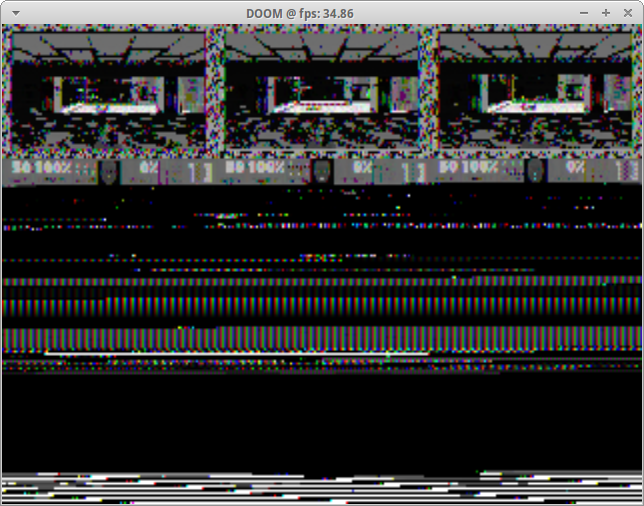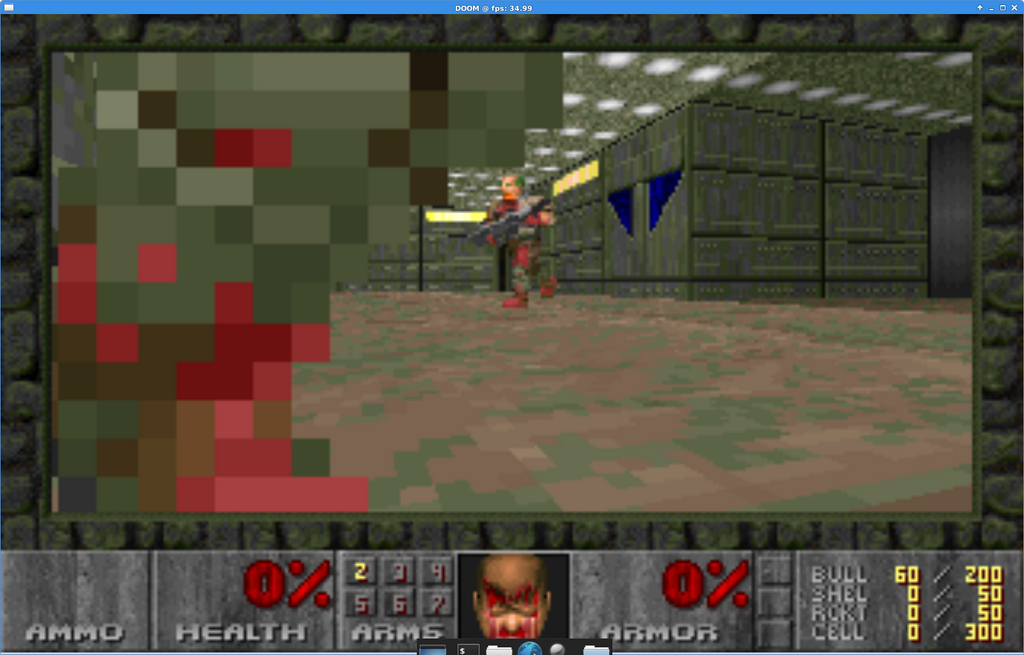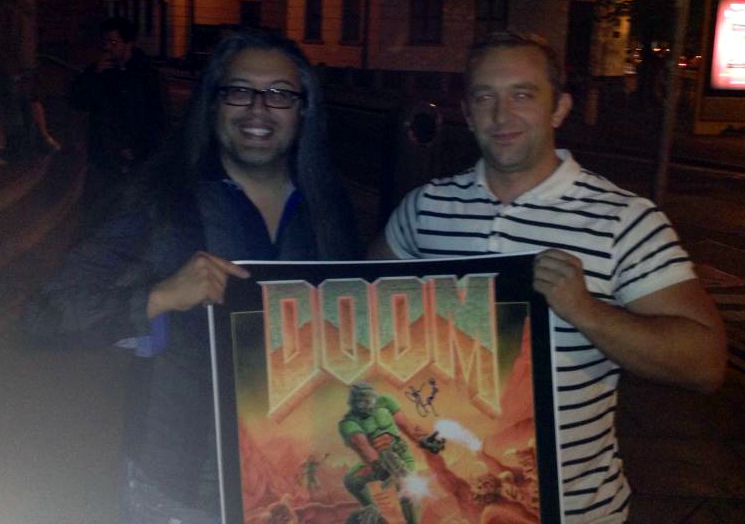
My port of the original DOOM code (which no longer works on desktops) to modern windowed output.
I've been having a look at the original DOOM source code, which id Software has put on GitHub: https://github.com/id-Software/DOOM. I wanted to see if I could follow their source code, and maybe find something neat for my bag of tricks.
I ended up succesfully porting the video output to a modern platform-independent OS window on 64-bit machines too!

My port of the original DOOM code (which no longer works on desktops) to modern windowed output.
The first thing that strikes me is that it's in C, not C++, and actually the style and conventions are almost exactly the same as those I've grown to prefer myself. They use C++ comments, with some blank comment lines to emphasise headings for functions and things:
Otherwise it's pretty much GNU-standard style, which I think I saw John Carmack support in a tweet somewhere. They even have GNU-standard Changelogs and Makefiles. The indentation is a bit messy - tabs are always assumed to be equivalent to 8 spaces or something crap like that. I guess that's the default in emacs or whatever they were using.
The really nice thing about this code is that it's bare-bones C. It has basically no external dependencies on dated DOS libraries that are gone. If you want to write code that lasts do re-invent the wheel, do not re-use code from others. There are some supporting utility functions however, but that's all plain C and included in the source. Notable missing external libraries used, which are absent for copyright reasons (Carmack notes in the README that he regrets using these):
They've replaced these in the '90s with a woefully out-of date X server for linux, and woefully out-of-date inadequate Linux sound system, neither of which will run on a modern system.
It's hard-coded to use 32-bit computing, and uses a lot of integer-pointer arithmetic. The problem with this is that on a modern, 64-bit computer, it won't compile because the size of integers is still 32-bits but the size of pointers has doubled to 64-bits. 64-bit pointers let us do wonderful things like address more than 4GB of memory. The compiler is disgusted by any such 32-64 number comparisons. Integer/pointer comparisons are not a great idea anyway, and these days we have some data types to abstract these problems.
There were a few bugs in the source which look like were errors introduced post-release to cope with the third-party add-on episodes. The compiler found these, and it was easy to fix them. Mostly just a case of strings for map names being longer than the allocated memory for the string. An incorrect system header for error numbers was used - I just renamed that.
There are little scraps of assembler code inlined, which is pretty neat, and these seem to play well with a GCC compile.
One neat trick that I found was a nice way to check all the command-line parameters for a particular phrase. I always did this the hard way in a big nest of if-else clauses:
Another neat trick that I somehow missed thus-far is that in a Makefile you can flag-in some #defines that affect your code! It's just a -D flag, so you can do stuff like -Danton, and then in your code put some #ifdef ANTON to get a special build.
The README says that it can only run now on Linux. Actually that's not true; it won't run on anything, but it will eventually compile on Linux. There was probably a period of time for about 1 year after source release where a display driver for a large, beige-coloured CRT would accept a resolution ratio of 320x200 at 35Hz. The main problem now though is actually the older 32-bit hard-coded stuff. I didn't want to tediously fix all the 32-bit pointer arithmetic, so I just modified the Makefile to use 32-bit libraries and compile for 32-bit. It didn't work - I was missing a whole lot of 32-bit libraries on my 64-bit Xubuntu machine.
After updating my 32-bit development libraries it actually compiled! Imagine my elation. Now, the video code that they'd Frankensteined onto the end expected you to run a 320x200 full-screen 8-bit X display at 35Hz. I thought, "Hey, why not try it - for science?", even though I knew my video resolution supported a full-screen minimum of 640x480, and even scaling-up 320x200 a couple of times probably wouldn't work (wrong aspect ratio). It was a bad idea - I broke my video config and couldn't boot back in to my user account until I wiped all my video config manually from another super-user terminal, and fiddled with the incorrectly re-generating .Xauthority. Damnit linux! End of first evening.
Not to be beaten, I was convinced that this old DOS display stuff must be pretty easy underneath the hood. It must be raster graphics. It must write directly to pixels in a big 320x200 array of bytes. This must get copied entire-frame-by-entire-frame to the display interface by the game. My first step was to try to surgically remove all of the X-display interface and get it to compile and run without any graphics - just on a terminal. The nice thing about id's code style is that it's arranged the same as mine - one code module per .c file. I quickly fgrepped and found it was all in i_video.c (presumably 'i' for interface). It also had a whack of crappy X-server keyboard event code there too. And some horrible hacky "add a mouse cursor but make it invisible and also make sure it stays inside the boundaries of the 'window' so the programme doesn't lose focus on the OS". What a load of horrible linux crapware (I can't stand the X+distribution window layers on top of GNU/Linux - unreliable shite). I knew what I had to do at this point. I commented out all the X interface code (easily spotted) and headers. I commented out all the user input too (also X event stuff). And guess what - it worked!
So I had Doom's demo loop running in a terminal window, with the familiar load-up printfs, and some error messages every few frames complaining that my WAD was a different version to the source code. Encouraging! Now, could I fiddle around with graphics and get anything to write to a pixel or two? My general plan forming at this stage was to use a platform-independent windowing library to let me draw to a window instead of fullscreen. This would:
I kind-of liked some of the modern Doom ports which also add fancy lighting and transparent stuff and even 3d models, but it's not the same as having the original code, and even the original pixelated graphics! So I wanted to keep it as pure as possible, but get some sort of display out. I didn't feel bad about trashing the X interface stuff, because that wasn't in the original anyway. Also, if I was to change some stuff like game code (weapon damage, AI?) then I wanted to see if I could improve the original, not modify someone else's replacement code.
I quickly found the 320x200 array I was looking for being passed to X - a buffer called image.data in bytes. It looked promising. I knew I could make OpenGL expect an 8-bit RGB source image, so my plan, as it stood, was to copy this into a texture, and throw this onto a full-screen quad with some simple nearest-neighbour image sampling. I went hunting for all the DOOM code that copied bytes into this buffer, and put my own buffer there instead.
I pulled out my 32-bit linux laptop and made sure I had a 32-bit libGL.so (I later found I had this on my 64-bit machine too, but oh well). I successfully started up GLFW and GLEW, and got a system window at 320x200px with a viewport the same size (it's tiny now). I got something! I got noise in my image! Okay, so maybe this was going to be too hard, maybe not - but....but I found I was missing a few data copies, and fixed that. This is what I got:

It's upside-down. It has crap in it. It's repeated 3 times. The colours are wrong. But it clearly says "DOOM". I knew I was in business at this point.
I actually expected it to be-upside down, and this was easily fixed by inverting the T-axis in my vertex shader where I derive my texture-coordinates per-vertex. The noise and tripling I figured was probably a mis-match between amount of data expected and amount of data actually in the image buffer. Thinking about it the buffer had 320x200 bytes in it, but I was expecting 320x200x3 (x1 byte each for red, blue, and green channels for each pixel). I hoped that there wasn't some special format for colour values, or some special bit-encoded custom format for each pixel. This didn't sound right though - less than 256 colours per pixel wouldn't be enough for DOOM's quite rich colours. It had to something to do with the palette system that Carmack mentioned in the README as an expected difficulty. Anyway, keeping this on the back-burner I flipped the display and added keyboard controls for ESCAPE, ENTER and UPARROW. I got what I had hoped for:

The ESCAPE and ENTER buttons let me bring up the menu (phew, it worked!), and start E1M1. When UPARROW let me actually move in 3d I knew I was about to crack the whole thing. The game loop and movement motion worked perfectly!
I saw an article here about the colour palettes used in different games based on the Doom engine. It looks like they used a single look-up table which could be replaced for different game art styles. They could even change the palette in-game to have special effects like whole-screen flashes or whole-screen red when the player is hurt. Neat. This had to be what I was assuming was the final image - the 320x200 bytes buffer. Each value wasn't a colour at all, but an arbitrary combination of colours. This meant that there was a look-up table in the main code somewhere which would set the red, blue, and green values of each palette index. I dug around (well, fgrepped) until I found it. And there it was - exactly what I needed for my image. I just reversed this palette-encoding function to "correct" my image buffer from 320x200 palette indices to 320x200x3 RGB values, 8-bits per channel. I figured X must have already been asking for this, but nope, their display function was taking the palette as a function parameter to the X display function (what the hell X, what kind of weirdo 1980s display are you?).

ULTIMATE VICTORY! I never thought I would get this far with such old code, written by other people. I scaled up to 640x400. Because I'm sampling a texture I can resize my viewport to any dimensions and it will work - I'll try to keep to factors of 320x200 though.
So, I tested it, and it runs on my 32-bit and 64-bit machines, and I know I can easily compile the same code on Windows 32 and 64-bit now too! Apple should work, as long as it doesn't mind compiling in 32-bit mode on the newer 64-bit machines. I don't fancy fixing all the pointers (there are hundreds and hundreds).
I got a lot more of the keyboard keys working, although my code is a bit messy. It also runs Doom II! I can turn on anti-aliasing to fix most of the original pixellation-due-to-scaling issues in a nice way, but leaving the filters in GL_NEAREST feels right for now.

IDBEHOLD the aliasing!
The entire process took 2 evenings of my gamedev time. Always worth it challenging yourself to new things! I'll tidy it up, add the rest of the keyboard controls, and post the code somewhere. There are loads of great Doom ports, but I think this might be the most minimal whilst reliably working. Stuff I didn't do:
On a related note, I also met Brenda and John Romero after a talk at DIT in Dublin, and got John to sign my Doom poster! Chatted about Dangerous Dave.

We're not worthy!